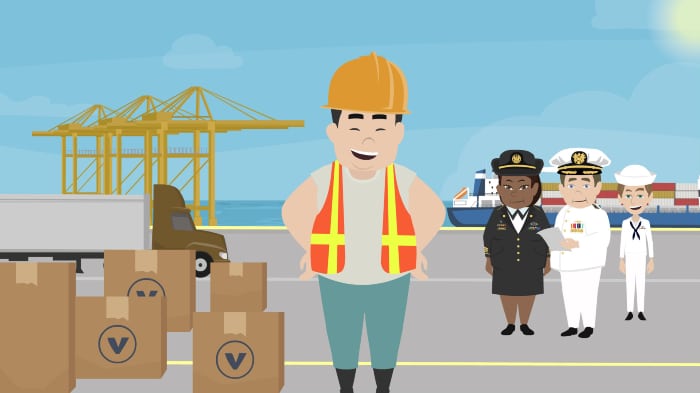This is a guest post for ICC Academy by Christoph Martin Radtke, Partner at Fiducial Legal by Lamy and Co-Chair of the international Incoterms® 2020 Drafting Group. Christoph is also the Chair of the Commission “Commercial Law and Practice” for ICC France. The views expressed in this article do not necessarily represent the views of the ICC.
Based on queries to the International Chamber of Commerce (ICC), the two most popular Incoterms® 2020 Rules are FCA and DAP. These rules can throw up some tricky questions regarding how they interface between the contract of carriage and issues surrounding transport documents, customs clearance and logistics.
This article will highlight how the new ICC Handbook on Transport and the Incoterms® 2020 Rules can provide practical answers to a variety of situations, using the two questions below as examples:
- How can a FCA seller provide the buyer with a bill of lading?
- How can a DAP seller safely deliver the goods after the customs border in the country of import?
ICC Handbook on Transport and the Incoterms® 2020 Rules
In 2021 the International Chamber of Commerce (ICC) published the “ICC Handbook on Transport and the Incoterms® 2020 Rules”. The handbook’s purpose is to highlight certain issues that must be considered by the buyer or seller when contracting for carriage in connection with a contract of sale using a specific Incoterms® rule.
It is very important to keep in mind that the contract of sale and the contract of carriage are separate contracts, involving different parties as well as entirely different sets of obligations. Regardless of whether it is the seller or the buyer that contracts for carriage, it is crucial to understand the full scope of the parties’ obligations when entering into the contract of sale and using a specific Incoterms® rule.
As a starting point, I would like to stress that it is fundamental to have a clear and comprehensive understanding of how to deal with the Incoterms® 2020 Rules. It is imperative to really study the official ICC publication containing an introduction and the official text of the 11 rules preceded by explanatory notes for users. It is not enough to read short summaries. This does not make you understand the Incoterms® Rules or the obligations they impose regarding transport.
Incoterms® 2020 do not bring revolutionary innovations compared to the previous version. But they contain numerous improvements in the explanations and the details of the presentation of the articles A1 to A10 and B1 to B10, notably on customs formalities which can be found in A7 and B7 of each rule. So, it made sense to update the "ICC Guide on Transport and the Incoterms® 2010 Rules” which was based on the Incoterms® 2010, and adapt it to Incoterms® 2020.
ICC deliberately chose to rename it "Handbook" to avoid confusion with the late Ian Ramberg’s "ICC Guide to Incoterms® 2010 ", which existed for the 2010 version but does not yet exist for the 2020 one.
The Incoterms® Rules apply worldwide to all situations and to all types of goods and transport. They cannot regulate in detail what happens during transport. Therefore, it makes sense to explain to the party that has to conclude the transport contract, what is to be regulated in detail in the transport contract - depending on the Incoterms® rule used in the contract of sale.
The handbook is structured rule by rule, duty by duty, with each explained in turn. Of course, the transport contract then must be agreed between the carrier and whoever is the party to the transport contract, which is defined in A4 and B4 of each Incoterms® Rule. The handbook contains practical answers for various situations (see two examples below) - always with the note that this advice is of a general nature and that the parties must agree the details for their individual situation.
How can a FCA Seller provide the buyer with a bill of lading?

Incoterms® Rules are not made to provide a direct and detailed answer to all transport issues. Incoterms® Rules are part of the sales contract, not part of the contract of carriage.
But the answer to this question can be found in the ICC Handbook on Transport and the Incoterms® 2020 Rules and reads as follows:
“The FCA Incoterms® 2020 rules may be used irrespective of the mode of transport selected and may also be used where more than one mode of transport is employed. As such rule does not refer to any particular type of transport mode/document, and the buyer and the carrier may agree on whatever transport document is convenient for them.
Most international transport conventions require the carrier to deliver a specific transport document or cargo receipt such as an Air Waybill (AWB), Bill of Lading (B/L), or Road Consignment Note (CMR) in respect of cargo received for carriage. If the carrier issues such a document at the request of the FCA seller – an option for the FCA seller now expressly provided for under article B6 of the FCA Incoterms® 2020 rule -, it shall generally be deemed to have done so on behalf of the buyer for purposes of the contract of sale, subject to proof to the contrary.
The transport document serves as proof that goods have been taken into the custody of the carrier (see Acknowledgment of receipt above) and as the place to note any reservations about the goods. In other situations, the transport document might be used in a way that only the holder of the transport document is entitled to claim the goods (such as with a negotiable Bill of Lading).”
How can a DAP Seller safely deliver the goods after the customs border in the country of import?
The answer to this question can also be found in the new ICC handbook and reads as follows:
“If the named place in a DAP sale is situated within the country of import, it may be advisable to instruct the carrier to split up the price of transport into ‘inland’ and ‘international’ transport costs for customs valuation purposes.
When a DAP seller organizes the logistics chain up to and inland named point of destination, the most logical solution would be for that seller not only to instruct carriage, buy all the other aspects of logistics (insurance, customs clearance, warehousing…) up to the moment that the goods are handed over to the buyer (or its agent) at the named place of destination. As the freight forwarder, working under instruction of the seller, is indeed the ‘architect of logistics’ it may be best placed to not only manage transportation of the goods but also all the accessory activities (e.g. warehousing, customs clearance, insurance) up to the point where its mandate ends. Although customs clearance upon import is to be carried out by the DAP buyer, it may be practical to ask the seller’s freight forwarder to organize all the customs formalities (customs clearance, loading of the goods) prior to arrival at the named inland place of destination in the name of the buyer. This would keep all logistics in one hand and avoid the risk of delays and errors.
To avoid inconsistency, the seller should agree on terms and conditions in the contract of carriage with the carrier in line with the assignment of obligations of the seller and the buyer regarding customs clearance under the DAP Incoterms® 2020 rule.“
I am sure that users of the new handbook will find it a valuable addition to the Incoterms® 2020 publication. It will serve to harmonize practice between sellers, buyers and carriers worldwide. This is ultimately in the interest of companies because it saves time and money when concluding contracts of carriage.

